List of the bishops of Speyer
The list of the bishops of Speyer , the number of bishops of the Roman Catholic Diocese of Speyer before that from 1546 to 1801 and 1810 to the rank of prince-bishops revenue as well as in personal union also to 1789 prince provosts of the prince provost White Castle were.
Historical overview
A complete series of bishops began in the Speyer diocese as early as the middle of the 7th century. The first bishops are usually abbots of the region's monasteries. Afterwards it was count families , like the House of Leiningen , who repeatedly provided bishops, gradually members of knightly noble families also gained high spiritual dignity. The von Helmstatt family was particularly influential in the 15th century . The families of origin come from Kraichgau , Alsace or were Rhenish, Hessian, Swabian or Franconian noble families.
The religious center of the diocese has been the Speyer Cathedral since its completion in 1061 . The auxiliary bishops of Speyer and the canons of Speyer play an important role . The court offices of the bishops of Speyer performed other important tasks . Quite a few bishops were initially canons of Speyer or neighboring dioceses. In the period of the late Middle Ages to the early modern period which consisted cathedral chapter of provost , Domdekan , Domscholaster , choirmaster , domkustos and 25 canons . After secularization , the positions were also accessible to commoners, who in the 19th century often still - such as B. Johannes von Geissel - a staff nobility was awarded.
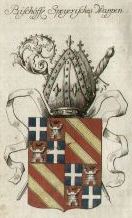
In the Middle Ages, with the increasing influence of the bishops on Speyer and the surrounding country, tensions with the cathedral chapter and the citizens of the city of Speyer came again and again. In the pursuit of rights acquired Speyer finally after centuries the status of a free city and a free city (see history of the city of Speyer ). As a spiritual principality in the Holy Roman Empire , the bishops were repeatedly called upon to position themselves vis-à-vis kings and between king and pope. The Archdiocese of Mainz , the Wittelsbach Count Palatine and other neighboring territorial states also exerted influence on the diocese.
The coats of arms of the bishops have increased over centuries , i. That is, they usually contain the original family coat of arms and next to it the coat of arms of the Speyer diocese. A crossing with the two coats of arms is common. A silver cross stands for Speyer on a blue background. From 1546 to 1789 the prince-bishops were also prince provosts of the prince-provost of Weissenburg , the property of the monastery in Alsace was integrated into the bishopric. Therefore a coat of arms component is the associated motif of a silver castle with gate and two towers, above a golden crown on red. If the bishop was also bishop of other dioceses, the coat of arms consisted of further elements - in the picture u. a. solved by a heart shield or other divisions. Today's bishops' coats of arms tie in with this tradition.
The old prince-bishopric of Speyer existed on the right bank of the Rhine until 1810, the parts of the diocese on the left bank of the Rhine fell under constitutional law to France in the Peace of Lunéville in 1801 and were divided under canonical law between the dioceses of Strasbourg and Mainz.
In 1817, from various areas on the left bank of the Rhine of the former dioceses of Speyer, Mainz, Worms, Strasbourg and Metz, today's diocese of Speyer, with the episcopal city of the same name as its center, was newly formed.
List of the bishops of Speyer
| No. | bishop | from | to | Remarks | Illustration | coat of arms |
|---|---|---|---|---|---|---|
| 1 | Jesse | at 346 | Jesse is considered to be the first Speyer bishop to be handed down long before the other bishops outside the contiguous list of bishops. | |||
| 2 | Hilderich | at 614 | Hilderich lived around 600 and is the first tangible bishop of Speyer, with whom the related list of bishops begins. In 614 his participation in the Paris Council convened by the Frankish King Chlothar II is documented. In 616 he consecrated the deacon Johann as bishop in Constance . | |||
| 3 | Athanasius | ? | 650 | Athanasius was court chaplain of King Dagobert I. Under his episcopate, the first Merovingian cathedral was built in Speyer and the Germansberg abbey was founded there, and the Klingenmünster monastery in the surrounding area . | ||
| 4th | Principius | 650 | 659 | King Sigibert III. Principius calls around 650 in a deed of donation for the tithe in Speyergau an "apostolic man" and his "father and lord", which suggests a closer relationship between the two. The generous donation laid the foundation for the financial security of the diocese of Speyer until secularization. | ||
| 5 | Dragobodo | 660 | 700 | Dragobodo is considered to be the founder of Weißenburg Monastery and was abbot there. As Bishop of Speyer, he received a privilege from King Childerich II , which exempted the diocese from any royal tax. Dragobodo signed at the Synod of Trier, 664, together with Bishop Chlodulf von Metz, the document establishing the Vosges monastery of Saint-Dié . In the pontificate of Dragobodos on September 10, 670, near Rülzheim not far from Speyer, Bishop Theodard of Maastricht was murdered by Frankish nobles and temporarily buried (later transferred to Liège ). A pilgrimage site, one of the oldest in the diocese of Speyer, was built at the place of his death. | ||
| 6th | Atto | 701 | 709 | Atto is listed in the oldest Speyer bishops list, which was created between 1078 and 1088 in the Schäftlarn Abbey , under the name Ato and is only in 8th place. However, the group of the first 8 bishops there is incomplete and in disorder. According to Jakob Baumann ( Der Pilger , 1906) there are no documents about him; he is only known by name from the abovementioned list of bishops or from tradition. The other sources only offer Atto's presumed government data. | ||
| 7th | Sigwin | 709 | 725 | Sigwin is listed in the oldest Speyer bishops list, which was created between 1078 and 1088 in the Schäftlarn Abbey , under the name Sigiwin and in the correct 7th position. According to Jakob Baumann ( Der Pilger , 1906) there are no documents about him; he is only known by name from the abovementioned list of bishops or from tradition. Sigwin's pontificate falls into the warlike time of the decline of the Merovingian dynasty and the beginning of the effectiveness of St. Philip of Zell , St. Pirminius and St. Bonifatius . | ||
| 8th | Luido | 725 | 743 | According to tradition, Luido was a monk from the Weissenburg monastery; Wilhelm Eisengrein (1543–1584) describes him in 1564 in his Speyer Chronicle as a “saint”. 738, St. Bonifacius brought from Rome a letter from Pope Gregory III. with, in which Bishop Luido is named. Around 740 he took part in the Synod of Regensburg, 742 also in the very important 1st German National Council ( Concilium Germanicum ). | ||
| 9 | David | 743 | 759 | David was also abbot of Weissenburg Abbey and appears with this function in documents there from 744. He took part as Speyer Shepherd in the Franconian synod of 747 in Mainz. During his reign, with a papal bull dated November 4, 748, the diocese of Speyer was subordinated to St. Boniface in Mainz as a suffragan diocese. During his pontificate, St. Pirminius and St. Philipp von Zell died in today's diocese of Speyer . | ||
| 10 | Basinus | 762 | 770 | |||
| 11 | Fraido | 782 | 804 | Fraido, also Flaido , is also known as the Abbot of Klingenmünster . | ||
| 12 | Benedict | 814 | 829 | |||
| 13 | Hertin | 830 | 845 | also Bertin | ||
| 14th | Gebhard I. | 845 | 880 | also Gebehard | ||
| 15th | Thank you | 881 | 895 | |||
| 16 | Einhard I. | 895 | 913 | also Meinhard | ||
| 17th | Bernhard | 914 | 922 | |||
| 18th | Amalrich | 923 | 943 | |||
| 19th | Reginbald I. | 944 | 950 | Reginbald I., also Reginhard , took part in the universal synod of Ingelheim . | ||
| 20th | Gottfried I. | 950 | 960 | |||
| 21st | Ottgar | 962 | 970 | |||
| 22nd | Balderich | 970 | 986 | |||
| 23 | Rupert | 986 | 1004 | |||
| 24 | Walter | 1006 | 1031 | Walter went down in history as a poet, and some of his works have survived. He was court chaplain of Otto III. | ||
| 25th | Siegfried I. | 1031 | 1031 | |||
| 26th | Reginger | 1032 | 1033 | |||
| 27 | Reginbald II. | 1033 | 1039 | Reginbald II of Dillingen, also Regimbald , was first abbot of the monastery of Sankt Ulrich and Afra Augsburg , monastery Ebersberg and then of the monastery Lorsch . He is considered pious and educated, and he is revered as a blessed. During his time as bishop, King Konrad II began building the Speyer Cathedral . |
 Sarcophagus lid in the Speyer Cathedral |
|
| 28 | Sigibodo I. | 1039 | 1051 | Sigibodo I came from a Franconian family and received his spiritual training in Speyer. Under Sigibodo, the All Saints Monastery was built not far from the Speyer Cathedral . | ||
| 29 | Arnold I. | 1051 | 1056 | Arnold I. probably came from the family of Falkenberg of Burg Falkenberg . He was first abbot in the Weissenburg monastery . | ||
| 30th | Konrad I. | 1056 | 1060 | |||
| 31 | Einhard II. | 1060 | 1067 | Einhard II came from the family of the Counts of Katzenelnbogen . In November 1061 he is said to have taken the veil for Agnes von Poitou in Speyer . |
 Family coat of arms in the Ingeram Codex |
|
| 32 | Heinrich I. von Scharfenberg | 1067 | 1072 | see also Scharfenberg Castle | ||
| 33 | Rüdiger called Huzmann | 1074 | 1090 | Rüdiger headed the renowned cathedral school , where Benno von Osnabrück worked as a teacher. In the investiture controversy, Rüdiger stayed on the side of King Henry IV as bishop . For his activities loyal to the king, he was banned by Pope Gregory VII . In order to break the spell, he went to Rome and took a monastery on himself. Back as bishop he risked another ban, which had no further effects in Speyer, which was also loyal to the emperor. Heinrich IV strengthened the position of the diocese primarily by donating two counties, including parts of the Speyergau . | ||
| 34 | John I. | 1090 | 1104 | Johannes I was a count in Kraichgau and came from the Zeisolf-Wolfram family . As a supporter of the Salians , Heinrich remained on the side of Henry IV in the investiture dispute . When the crusaders passed through in 1096 , he placed the Jews under his personal protection. | ||
| 35 | Gebhard II of Urach | 1104 | 1107 | Gebhard II. Von Urach, also Gerhard , came from the family of the Counts of Urach . Gebhard has been known as abbot in Hirsau Monastery since 1091 as the successor to Wilhelm von Hirsau . | ||
| 36 | Bruno of Saarbrücken | 1107 | 1123 | Bruno von Saarbrücken came from the dynasty of the Counts of Saarbrücken , who were entrusted with important offices by the Salians . Bruno was the son of Count Siegbert and a brother of Friedrich von Saarbrücken and the Archbishop of Mainz Adalbert I of Saarbrücken , and thus also the uncle of Adalbert II of Saarbrücken (see also list of Counts of Saarbrücken ). Before Bruno became Bishop of Speyer, he was an abbot at Lorsch Abbey . | ||
| 37 | Arnold II of Leiningen | 1124 | 1126 | Arnold II von Leiningen came from the von Leiningen family , who later provided other Speyer bishops with Heinrich von Leiningen and Emich von Leiningen . His time as bishop only lasted a few years. |
 Family coat of arms |
|
| 38 | Siegfried II of Wolfsölden | 1127 | 1146 | In the dispute over the crown, Siegfried II supported the Guelph Lothar III. , the Staufer-friendly city of Speyer adhered to the anti -king Konrad III. and initially drove the bishop out of the city. During the siege of the fortified city by Lothar III. and the Archbishop of Mainz Adalbert I of Saarbrücken , the starved Speyer finally had to bow. After the death of Lothar III. However, the Staufer prevailed. | ||
| 39 | Günther von Henneberg | 1146 | 1161 | Günther, like his brother, was a follower of the Staufer . His greatest achievement was the relocation and re-establishment of the Maulbronn Monastery in 1147, which thus developed into one of the most important bases of spiritual life in the Black Forest . |
 Board of donors, right inner wing. Bishop Günther von Henneberg and Walter von Lomersheim offer the Mother of God their foundation. |
 Family coat of arms in Scheibler's coat of arms book |
| 40 | Ulrich I. von Dürrmenz | 1163 | 1163 | Ulrich I is listed as Chancellor of Emperor Barbarossa on August 30, 1159 . This is likely to have had a considerable influence on Ulrich's election as bishop in 1162; Ulrich was given the conflict between the emperor and Pope Alexander III. not confirmed as bishop by the Holy See. Ulrich's term of office was marked by disputes with the citizens of Speyer. |
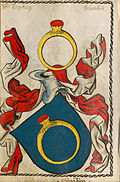 Coats of arms of the Enzberg in Scheibler's book of arms |
|
| 41 | Gottfried II. | 1164 | 1167 | |||
| 42 | Rabodo of Lobdaburg | 1173 | 1176 | Rabodo came from the Lobdeburg family . | ||
| 43 | Konrad II. | 1176 | 1178 | |||
| 44 | Ulrich II von Rechberg | 1178 | 1187 | Ulrich II von Rechberg came from the Swabian noble family of the Counts von Rechberg . Ulrich II is one of a number of Speyer bishops who were closely related to the Hohenstaufen emperors. |
 Family coat of arms in Johann Siebmacher's coat of arms book |
|
| 45 | Otto von Henneberg | 1190 | 1200 | Otto came from the Frankish counts of the von Henneberg family , who a few decades earlier had already provided a bishop in Speyer with his brother Günther von Henneberg and who were also represented as bishops of Würzburg several times in the 12th century . Otto is one of a number of Speyer bishops who were closely related to the Hohenstaufen emperors. |
 Family coat of arms in Scheibler's coat of arms book |
|
| 46 | Conrad III. from Scharfenberg | 1200 | 1224 | Conrad III. was also Bishop of Metz since 1212 . | ||
| 47 | Ringers of Entringen | 1224 | 1232 | Beringer was an advisor to King Henry VII and took part in the court day in Worms in 1231. The Cistercian convent Heilsbruck and the Reuerinnenkloster St. Magdalena were founded during his time . The Franciscans were allowed to move their branch to the city of Speyer . |
 Coat of arms of the Beringer von Entringen from Alberti's coat of arms book |
|
| 48 | Conrad IV of Tann | 1233 | 1236 | Konrad IV came from the Dahn ministerial . In 1220/1221 he accompanied Bishop Conrad III. von Scharfenberg on his trip to Italy, in 1227 he was a representative of the imperial government in England, for negotiations with King Henry III. As bishop, his participation in two synods against the persecution of heretics of Konrad von Marburg and his related dispatch of a Speyer cleric to report to Rome is documented. He died on Christmas Eve 1236. | ||
| 49 | Konrad V. von Eberstein | 1237 | 1245 | Konrad V came from the noble family Eberstein , his mother was one of Andechs . Through her he was closely related to St. Hedwig and St. Elisabeth of Thuringia . Politically, he was one of the partisans of Pope Innocent IV against the Hohenstaufen . He was buried in the Herrenalb family monastery . |
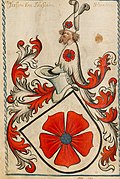 Family coat of arms in Scheibler's coat of arms book |
|
| 50 | Henry II | 1245 | 1272 | Heinrich II. Occupied Würzburg because of a papal expectance, which was horrified in 1255. After an arbitration, he renounced his claims as Bishop of Würzburg (1254-1255) and died in 1272 as Bishop of Speyer. In 1270 the Bishop's Palatinate Speyer was first documented. |
 Family coat of arms |
|
| 51 | Friedrich von Bolanden | 1272 | 1302 | Friedrich came from the von Bolanden family . | ||
| 52 | Sigibodo II of Lichtenberg | 1302 | 1314 | Under Sigibodo, there were massive clashes with the city of Speyer. At the end of acts of war, the bishop largely fulfilled the demands of the citizens. |
 Family coat of arms in the Ingeram Codex |
|
| 53 | Emich | 1314 | 1328 | Emich gave Ludwig to Bavaria on his Italian campaign together with the Eichstätter Bishop Gebhard III. von Graisbach the anointing as king of Lombardy . Since he was a partisan of Ludwig's judgments from Pope Johannes XXII. not published, he was excommunicated in 1327 . |
 Family coat of arms |
|
| 54 | Berthold von Buchegg | 1328 | 1328 | Pope John XXII. selected Berthold as an opponent of Ludwig of Bavaria . Despite warnings from the Pope, the Speyer canons held elections and opted for Walram von Veldenz . Berthold could not keep himself in Speyer even with military means and became Bishop of Strasbourg (1328-1353). | ||
| 55 | Walram from Veldenz | 1329 | 1336 | Walram von Veldenz was in 1329 by Pope Johannes XXII. appointed who asked his predecessor Berthold von Buchegg to vacate the bishopric. Walram was a supporter of Ludwig of Bavaria and represented the interests of his lineage relatives. Due to the long-term financial difficulties of the bishopric, Walram handed over his secular functions to an administrator in the person of Baldwin of Luxembourg in 1330/1331 . | ||
| Baldwin of Luxembourg | 1332 | 1336 | In the last years of Walram von Veldenz , Balduin was administrator of Speyer and also administrator of Mainz (1328-1336). He was also Bishop of Trier (1307-1354). |
 Middle: Balduin, picture cycle of the Codex Balduini Trevirensis 1341 |
Modern window picture of the prince-bishop's coat of arms |
|
| 56 | Gerhard von Ehrenberg | 1336 | 1363 | With Gerhard from the von Ehrenberg family , a bishop from the Kraichgau knighthood was elected for the first time . First, employees of the law firm of Ludwig of Bavaria , he was in his favor, and changed only after his death on the side of Charles IV. The persecutions of 1349 as proliferations of the plague he could not prevent. |
 Replica of the epitaph |
 Family coat of arms in Scheibler's coat of arms book |
| 57 | Lamprecht von Brunn | 1364 | 1371 | Lamprecht, also referred to as Lambert, Lampert or Lambrecht in other sources, owed his position to imperial protection and personal qualities. In 1364/65 he first had to assert himself in Speyer against the opposing bishop Eberhard von Randeck , elected by the cathedral chapter , who finally resigned and was resigned. Since 1354 Lamprecht was abbot of the Gengenbach monastery in the Black Forest . 1363-1364 Lamprecht was also Bishop of Brixen , 1364-1371 he was Bishop of Speyer and 1371-1374 Bishop of Strasbourg . Only when he took office as Bishop of Bamberg (1374–1398) did he resign from his position as Abbot of Gengenbach. He was a close advisor to Charles IV and later Chancellor of his son King Wenceslaus the Lazy . Lamprecht distinguished himself from his neighbors through a sustainable peace policy. The only Carthusian monastery was founded in Nuremberg in 1381 . In 1395 he also founded the Elisabethen Hospital in Scheßlitz and donated his library to him. |
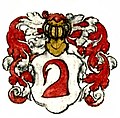 Family coat of arms after Lorenz Fries : Chronicle of the Bishops of Würzburg, 1574–1582 |
|
| 58 | Adolf I of Nassau | 1371 | 1381 | After studying law in Padua and Bologna , Adolf I was elected Bishop of Speyer at the age of 18 and then also Archbishop of Mainz (1381-1390). Due to two different parties that both wanted to see different candidates in the position of archbishop, disputes arose during his tenure between a coalition of princes and counts supported, including Duke Otto von Braunschweig-Göttingen , Johann von Nassau-Dillenburg , and Count Heinrich VI. von Waldeck and Count Gottfried VIII von Ziegenhain , who supported Adolf, and Emperor Karl IV , his son Wenzel , the three Margraves of Meißen (Ludwig's brothers) and Landgrave Heinrich II of Hesse . Only after the death of Pope Gregory XI. Adolf was confirmed in his position. Two weeks before his death, he founded the University of Erlangen . |
 Family coat of arms in the Ingeram Codex |
|
| 59 | Nicholas I of Wiesbaden | 1381 | 1396 | Nikolaus competed with his predecessor for the bishop's chair (see counter-bishop ). It was not until the death of Adolf I that Nicholas was generally recognized as a bishop. As protonator, he was also in charge of King Ruprecht's law firm . Due to the disputes during Adolf I's tenure, the financial situation of the bishopric was extremely strained. His alliances with the Count Palatine Rupprecht II. And Rupprecht III. led above all to the further strengthening of the influence of the Count Palatine in the interests of the diocese, which z. B. expressed in the occupation of the cathedral chapter and the bishop's seat. | ||
| 60 | Raban from Helmstatt | 1396 | 1430 | As usual in earlier times, Raban entered the cathedral chapter at a young age. During his tenure as Bishop of Speyer, he served as King Ruprecht 's Chancellor from 1400-1410 . In his function as Archbishop of Trier (1430–1439) he pledged the city of Cochem and Ehrenbreitstein Castle in the 1430s , which led to armed conflicts lasting several years. After he resigned from his office of Speyer Bishop on October 20, 1438, he also resigned from the office of Archbishop of Trier in 1439. |
 Family coat of arms in Scheibler's coat of arms book |
|
| 61 | Adolf von Eppstein | 1430 | 1433 | Adolf, who came from the von Eppstein family, was appointed Raban's successor on May 22, 1430 by Pope Martin V. After the death of Adolf von Eppstein in 1433/34 Raban von Helmstatt again administered the diocese. |
 Family coat of arms in Scheibler's coat of arms book |
|
| 62 | Reinhard von Helmstatt | 1438 | 1456 | In order to enable Reinhard to become bishop, his brother was forced to give up the office of provost and hand it over to him from 1424 onwards. This was finally fixed until 1436. As bishop, Reinhard laid the foundation stone for the Church of Our Lady in Bruchsal in 1447. |
 Family coat of arms in Scheibler's coat of arms book |
|
| 63 | Siegfried III. from Venningen | 1456 | 1459 | Through the marriage of his sister to Konrad von Helmstatt, a great-nephew of Raban von Helmstatt , Siegfried III came. and thus also the Venningen family in the highest Speyer circles. In his three years as bishop Siegfried III. the rapprochement between the diocese and the Electoral Palatinate continued and maintained a friendly relationship with Frederick I of the Palatinate . |
 Family coat of arms in Scheibler's coat of arms book |
|
| 64 | Johannes II. Nix von Hoheneck | 1459 | 1464 | Johannes II. Nix, who also had the suffix called Enzenberger , stood up in the Mainz collegiate feud against Friedrich I of the Palatinate . He had to submit to him after the battle of Seckenheim and was forced to abdicate on July 4, 1464. |
 Family coat of arms |
|
| 65 | Matthias von Rammung | 1464 | 1478 | Important reform bishop, at the same time Chancellor of the Electoral Palatinate . The historian Franz Xaver Glasschröder (1864–1933) described Matthias von Rammung as "the most important of the medieval Speyer bishops". He built the present choir of the Marienwallfahrtskirche Waghäusel , whose vault stone adorns his bishop's coat of arms. |
 contemporary book miniature |
 Wappenstein pilgrimage church Waghäusel |
| 66 | Ludwig von Helmstatt | 1478 | 1504 | Ludwig was the nephew of Bishop Reinhard von Helmstatt and the great-nephew of Bishop Raban von Helmstatt . From 1453 he is mentioned as Canon of Mainz and Speyer, from 1478 until his death as Bishop of Speyer. In Bruchsal he is named as the foundation stone of the old castle. During his reign there were significant tax increases for various reasons, which is considered one of the reasons for the spread of the peasant war to the diocese. The bishop was very dutiful and reformed the clergy. Jakob Wimpfeling praised his justice and piety in a poem. |
 Episcopal coat of arms, parish church St. Ulrich (Deidesheim) |
|
| 67 | Philip I. | 1504 | 1513 | Philip I combated the grievances among clergy and lay people in 17 still existing letters. He had a diocesan agenda printed by Peter Drach in Speyer. Under Bishop Philip I, the artistically very valuable Mount of Olives , a masterpiece of Renaissance sculpture that still exists today , was built south of the cathedral in 1509 . |
 Coat of arms seal of Bishop Philipp von Rosenberg, on the left the Speyer diocesan coat of arms with cross, on the right the family coat of arms of the von Rosenberg |
|
| 68 | George of the Palatinate | 1513 | 1529 | Georg, a Wittelsbacher , tried to counter the burgeoning Protestantism with prohibitions and to counteract the decline of religious life. He fled to Heidelberg during the Palatinate Peasants' War . He sought negotiations with the rebels, who were finally defeated by the Electoral Palatinate . In 1529 he took part in the Reichstag in Speyer . He died of an English sweat that same year . |
 contemporary painting on wood. |
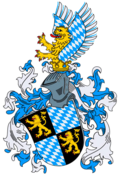 Family coat of arms of the Wittelsbach family |
| 69 | Philip II | 1529 | 1552 | Born in Kaiserslautern in 1481 as the son of the local electorate, Philipp studied in Heidelberg , Paris and Leuven , received his doctorate, became canon in Worms and Speyer in 1501 , rector of Heidelberg University in 1504; then cathedral singer in Speyer, cathedral provost in 1529 and Speyer bishop on October 22 of the same year. With kindness and religious zeal he tried to stop the Reformation in the diocese, which he only partially succeeded in doing. He consolidated the finances, and raised the wealth of his subjects. He was a political advisor to the emperor and other princes; also brother-in-law of Franz von Sickingen . He united the Propstei Weissenburg with the diocese. He died on August 14, 1552 in Zabern , on the run from the events of the Second Margrave War and was later buried in the Speyer Cathedral . |
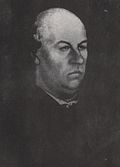 contemporary painting |
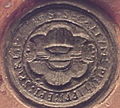 Coat of arms seal
|
| 70 | Rudolf von and zu Frankenstein | 1552 | 1560 | Rudolf came from the von Frankenstein family . After studying at various universities, he was canon in Mainz and after various diplomatic missions he was elected Bishop of Speyer. |
 Family coat of arms |
|
| 71 | Marquard von Hattstein | 1560 | 1581 | Hambach Castle , which was destroyed in 1552, was rebuilt under Marquard . |
 contemporary engraving |
 Episcopal coat of arms |
| 72 | Eberhard von Dienheim | 1581 | 1610 | In the period between 1583 and 1588 Eberhard visited his rural communities. The protocols received show worrying conditions that prompt Eberhard to reform. Many village pastors were poorly trained at this time and were dependent on additional farm work to make a living. |
 contemporary painting |
 Family coat of arms in Johann Siebmacher's coat of arms book |
| 73 | Philipp Christoph von Sötern | 1610 | 1652 | also Archbishop of Trier and Prince Abbot of Prüm (1623–1652) |
 contemporary engraving by Matthäus Merian |
 Prince-Bishop's coat of arms as an excerpt from an engraving of the Matthäus Merian family coat of arms in Johann Siebmacher's coat of arms  |
| 74 | Lothar Friedrich von Metternich-Burscheid | 1652 | 1675 | also Archbishop of Mainz (1675–1711) and Bishop of Worms (1675–1711) |
 contemporary painting |
Modern window picture of the prince-bishop's coat of arms |
| 75 | Johann Hugo von Orsbeck | 1675 | 1711 | (also Archbishop and Elector of Trier and Prince Abbot of Prüm ) Johann Hugo von Orsbeck studied at the Collegium Germanicum in Rome; In 1672 he was elected in Trier as coadjutor and successor to his uncle Karl Kaspar von der Leyen , with the date of July 16, 1675 as Bishop of Speyer. No sooner did he hold this office than his uncle died on June 4, 1676. Bishop Orsbeck now succeeded him in Trier and left Speyer forever; only once, namely in 1677, did he briefly return to the homage. On August 13, 1676, the shepherd appointed the able canon Heinrich Hartard von Rollingen as his representative in Speyer . Orsbeck was of great personal piety and a man of church consolidation. His government was overshadowed by the constant wars that were being waged over his territories. He was very beneficial in both dioceses, but in Speyer only through the hand of his long-time governor Hartard von Rollingen. Bishop von Orsbeck was buried in Trier Cathedral, his heart rests in Speyer Cathedral. |
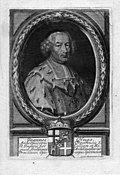 contemporary engraving |
|
| 76 | Heinrich Hartard von Rollingen | 1711 | 1719 | Rollingen studied at the Collegium Germanicum in Rome, was ordained a priest there in 1658 and officiated in 1661 cathedral chapter in Trier and Speyer. No sooner had Johann Hugo von Orsbeck become bishop of Speyer on July 16, 1675, when his uncle, the bishop and elector of Trier, whose successor he was, died. Bishop Orsbeck therefore left Speyer forever and on August 13, 1676 appointed the canon Heinrich Hartard von Rollingen as his governor there. He also received episcopal ordination. Under his governorship, the French occupied and devastated large parts of the diocese. In 1689 they burned Speyer down completely; only a ruin remained of the cathedral, which Rollingen saved from demolition. After the death of Bishop Orsbeck, the cathedral chapter unanimously elected him Bishop of Speyer on February 26, 1711. Rollingen - pious, very active and highly educated - was already 77 years old at this point. |
 contemporary painting |
 Prince-Bishop's coat of arms on the portal of the Catholic. Parish church St. Barbara, Hainfeld (1718) |
| 77 | Damian Hugo Philipp von Schönborn-Buchheim | 1719 | 1743 | Damian Hugo Philipp stands for a peaceful time in the diocese in which there was an economic and cultural boom. Damian Hugo Philipp managed to consolidate the state budget. He led u. a. the general compulsory education one. The bishopric was relocated to Bruchsal Castle . Damian Hugo Philipp was also Bishop of Constance from 1740 at the end of his life . |
 painting |
 Prince-Bishop's ornate coat of arms on the facade of Bruchsal Castle |
| 78 | Franz Christoph von Hutten to the Stolzenberg | 1743 | 1770 |
 painting |
 Prince-Bishop's coat of arms |
|
| 79 | Damian August Philipp Karl Count of Limburg-Vehlen-Stirum | 1770 | 1797 |
 contemporary painting |
||
| 80 | Philipp Franz Wilderich Nepomuk von Walderdorf | 1797 | 1810 | Philipp Franz Wilderich was the last Prince-Bishop of Speyer. The area on the left bank of the Rhine was secularized by France. The area on the right bank of the Rhine was added to the Margrave of Baden in 1802 . Philipp Franz Wilderich remained the head of the church for the area on the right bank of the Rhine until his death in 1810. |
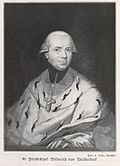 painting |
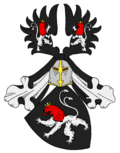 Family coat of arms |
| Sedis vacancy | 1810 | 1818 | In 1803 the prince-bishopric was secularized as secular territory. The part on the left bank of the Rhine had already fallen to France under constitutional law in 1801, while the part on the right bank of the Rhine became part of the Grand Duchy of Baden . In spiritual terms, the old diocese on the right bank of the Rhine continued to exist as a rump bishopric under the name of "Vikariat Bruchsal " until 1827 and was then incorporated into the Archdiocese of Freiburg . On the left bank of the Rhine, its areas of jurisdiction were subordinated to the large French dioceses of Mainz and Strasbourg as early as 1802 . Today's diocese of Speyer was completely re-established on the left bank of the Rhine in 1818 after the political re-affiliation of the areas on the left bank of the Rhine to Germany, using the old bishopric of Speyer and its famous cathedral . | |||
| 81 | Matthäus Georg von Chandelle | 1818 | 1826 | Chandelle was born in 1745 as the son of a Frankfurt wine merchant and was ordained a priest in Mainz in 1769. After the occupation of the areas on the left bank of the Rhine by the French, Chandelle fled to the right bank of the Mainz diocese, to Aschaffenburg, where he became an official, eventually director of the Aschaffenburg vicariate. When the Bavarian bishoprics were reorganized as a result of the Concordat, Chandelle was appointed bishop of the reborn Diocese of Speyer in 1818 after the originally planned Gregor von Zirkel had died. Chandelle was a bureaucrat and very orientated towards the state church. There were great tensions between the bishop and his clergy and the cathedral chapter. Died on June 30, 1826 and was buried in the city cemetery, later an epitaph was erected for him in the cathedral, but it is now in the cathedral chapter cemetery. |
 painting |
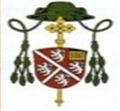 Episcopal coat of arms < Episcopal coat of arms on the tombstone  |
| 82 | Johann Martin Manl | 1827 | 1835 | Born in Mainz in 1766 as the son of farrier Andreas Mantel. Later changed his family name to Manl. Benedictine novice, then studied theology in Mainz; Ordained a priest there in 1789. In 1821 Johann Martin Manl became a cathedral chapter member of the newly established Metropolitan Chapter in Munich, and in the same year he became an official . On July 22, 1826, appointed Bishop of Speyer. Diligent about his official duties and the administrative management of the diocese; created a diocesan seminary, enlivened liturgical life and church singing. Pastoral care remained alien to him, he had more administrative talent. Because of contradicting views, the pastor fell out with most of the members of the cathedral chapter. He sought a transfer and became Bishop of Eichstätt on March 25, 1835 (1835). Here he died on October 15 of the same year of pneumonia and is buried in Eichstätt Cathedral. |
 contemporary painting |
Episcopal coat of arms |
| 83 | Peter von Richarz | 1835 | 1836 | Peter Richarz was born in 1783 as the son of a prince-bishop hussar from Bonn in Würzburg and was ordained a priest there in 1807. Since 1817 professor at the Würzburg University . King Ludwig I appointed Richarz Bishop of Speyer on March 23, 1835; at the same time he raised him to the nobility. Dedicated pastor and preacher, busily traveled and visited the local parishes. He became close friends with the cathedral capitals Johann Jakob Geissel and Nikolaus Weis , his two episcopal successors. In many things, however, he was quite headstrong, which led to resentment and dissatisfaction in the clergy. In order not to harm the diocese through his person, he applied after a short time for the vacant diocese of Augsburg and became bishop there (1836–1855). He died in Augsburg on July 2, 1855 and was buried in the local cathedral. |
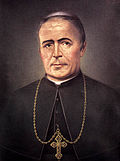 contemporary painting |
Episcopal coat of arms |
| 84 | Johannes von Geissel | 1837 | 1841 | Johann Jakob Geissel was born the son of a winemaker in Gimmeldingen in the Palatinate in 1796 and ordained a priest in 1818. In 1822 he became cathedral capitular in Speyer , in 1836 cathedral dean and in 1837 bishop. Since Geissel was the first shepherd from the region to come from the newly cut Diocese of Speyer, he knew the situation very well and performed his office with care and great commitment. He appointed his friend Nikolaus von Weis , who later became his episcopal successor, as vicar general. On September 24, 1841, Pope Geissel appointed Coadjutor of Archbishop Clemens August Droste zu Vischering for the Archdiocese of Cologne , who had been banished for political reasons . when the archbishop died in 1845, Geissel was his successor in Cologne (1845–1862). Under him, the Cologne Cathedral was already being built from 1842. Geissel became leader of the German episcopate during his tenure, and Pope Pius IX. appointed him cardinal in 1850 . He died in 1864 and was buried in Cologne Cathedral. |
 photography |
 Archbishop's coat of arms on the Marian column in Cologne |
| 85 | Nikolaus von Weis | 1842 | 1869 |
 photography |
||
| 86 | Konrad Reither | 1870 | 1871 |
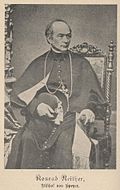 photography |
Episcopal coat of arms |
|
| 87 | Daniel Bonifaz von Haneberg | 1872 | 1876 | Born as a farmer's son in Tannen near Lenzfried (Kempten), studied philosophy and theology in Munich, graduated in 1839 and ordained a priest. 1840 associate professor, 1844 full professor at Munich University. Taught the subjects of the Old Testament and Oriental languages. 1848 appointment to the Bavarian Academy of Sciences . Haneberg was considered a linguistic genius. 1850 joined the Benedictine Abbey of St. Boniface in Munich, where he was elected abbot in 1854 . Participation in the 1st Vatican Council . Several times he rejected the appointment of bishops, but accepted the election of Bishop of Speyer in 1872 at the papal request. Zealous, tireless pastoral bishop, tall and impressive in figure. Carried out his office until he was completely physically exhausted and died in 1876 of pneumonia. Published theological books. |
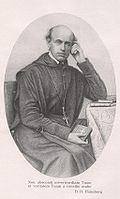 photography |
Episcopal coat of arms |
| 88 | Joseph Georg von Ehrler | 1878 | 1905 |
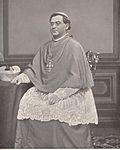 photography |
Episcopal coat of arms |
|
| 89 | Konrad von Busch | 1905 | 1910 |
 photography |
 Episcopal coat of arms in the choir of the Neustadt an der Weinstrasse collegiate church |
|
| 90 | Michael von Faulhaber | 1911 | 1917 | Michael was also Archbishop of Munich and Freising (1917–1952) |
photography |
 Episcopal coat of arms |
| 91 | Ludwig Sebastian | 1917 | 1943 |
 photography |
Episcopal coat of arms |
|
| 92 | Joseph Wendel | 1943 | 1952 | Joseph was then Archbishop of Munich and Freising (1952–1960), Military Bishop of the Bundeswehr (1956–1960) |
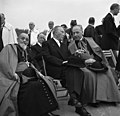 Photography by Joseph Wendel (right) together with Konrad Adenauer |
 Episcopal coat of arms |
| 93 | Isidor Markus Emanuel | 1953 | 1968 |
Episcopal coat of arms |
||
| 94 | Friedrich Weather | 1968 | 1982 | Friedrich was then Archbishop of Munich and Freising (1982-2007) |
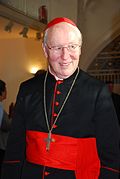 photography |
 Episcopal coat of arms |
| 95 | Anton Schlembach | 1983 | 2007 |
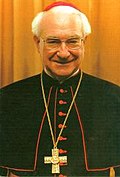 photography |
 Episcopal coat of arms |
|
| 96 | Karl-Heinz Wiesemann | 2008 |
 photography |
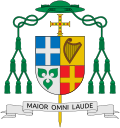 Episcopal coat of arms |
Non-contemporary representations of bishops
The problem with subsequent representations is basically the question of a realistic processing of historical connections.
Bishops in religious motifs
Abbot Reginbald is appointed bishop, from "Bavaria Sancta et Pia", 1615
Abbot Reginbald receives news of his election as bishop; Engraving from “Bavaria Sancta” by Magnus Jocham , 1861
Bishops on 18th century paintings
In the 18th century a number of paintings were made with portraits of medieval Speyer bishops. The motivation for this arose in part from the need to make clear periods of time that were mainly transmitted from written sources.
literature
- Ernst Friedrich Mooyer: Directories of the German bishops since the year 800 AD. Geb. , Minden 1854, pp. 103-104 .
- Hans Ammerich : The diocese of Speyer and its history . 7 volumes. Sadifa Media, Kehl am Rhein 1998-2006
- Georg Gresser : The diocese of Speyer until the end of the 11th century . In: Sources and treatises on the history of the Middle Rhine Church , Volume 89. Mainz 1998
- Franz Xaver Remling : History of the Bishops of Speyer , 2 volumes. Kirchheim, Mainz; Volume 1: 1852, Volume 2: 1854
- Max Wilberg : Regent Tables - A compilation of the rulers of countries on all continents up to the beginning of the 20th century . Transpress VEB publishing house for traffic, Berlin 1987 (= Frankfurt / Oder 1906). ISBN 3-344-00094-2
- Handbook of the Diocese of Speyer . 1991
Web links
Remarks
- ↑ Hans Ammerich : The Diocese of Speyer and its history , Volume 2: From the Staufer period (1125) to the beginning of the 16th century . Kehl am Rhein 1999, ISBN 3-927095-44-3 . P. 22
- ↑ Baldwin of Luxembourg appears in the official list of bishops ( memento of the original of April 26, 2013 in the Internet Archive ) Info: The archive link has been inserted automatically and has not yet been checked. Please check the original and archive link according to the instructions and then remove this notice. not counted







